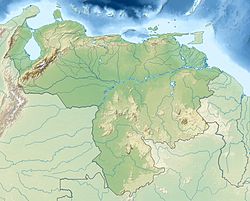Ilú-tepui
| Ilú–Tramen Massif | |
|---|---|

Southeastern face of Ilú-tepui as seen from Karaurín-tepui
|
|
| Highest point | |
| Elevation | 2,700 m (8,900 ft) |
| Coordinates | 05°24′18″N 61°00′20″W / 5.40500°N 61.00556°WCoordinates: 05°24′18″N 61°00′20″W / 5.40500°N 61.00556°W |
| Geography | |
| Location | Bolívar, Venezuela |
| Parent range | Eastern Tepuis |
The Ilú–Tramen Massif is a tepui massif in Bolívar state, Venezuela. It is the northernmost member of the Eastern Tepuis chain and comprises two major plateaus: the larger Ilú-tepui (also spelled Uru) to the south and Tramen-tepui to the north. With a maximum elevation of around 2,700 metres (8,900 ft), Ilú-tepui is the taller of the two peaks. Both tepuis have open, rocky summit plateaus, with a combined summit area of 5.63 km2 (2.17 sq mi). They lie just north of Karaurín-tepui.
Tramen-tepui, the left most tepuy in the photo below, was first climbed by Scharlie Wraight and Stephen Platt from the col between Ilú-tepui and Tramen-tepui on 24 November 1981.
In all Stephen Platt and Scharlie Wraight spent four weeks climbing Tramen Tepui. They failed on their first attempt in heavy rain trying to climb the west face directly below the huge chasm that splits the upper wall. They returned two weeks later and reached the summit on 24 November 1981.
At Uroy Uray they contracted a Pemon guide called José Luis who guided them to Uarpa. From there Pemon Indians Cecilio and Feliciano joined them and it took four days to traverse right to the col between Tramen and Ilu Tepui where the Indians left them.
On the 24 November they left their tent at dawn and climbed the steep vegetated talus slope to the first steep step. A difficult move up a steep vegetated corner led to a belay ledge below the plateau. They crossed the half-mile rock platform, leaving stone cairns and upturned pitcher plants every few metres to mark the route in case the swirling cloud descended. They skirted a rock pinnacle barring access to the upper wall and decided there might be time to reach the summit in one push.
They began climbing in the middle of the upper wall at an obvious niche. There followed two hard pitches. The first was a steep black slab without positive holds that led via a flake to a wide ledge and chock stone belay (Sport Grade 6b; UIAA Grade VII). The second pitch followed a crack line to a small pinnacle and then traversed up rightwards on wrinkled slabs to a grass ledge and a block pinnacle belay at the bottom of a steep chimney (Sport Grade 6b+; UIAA VII+). The third pitch led straight up the chimney where a chock stone at half height was the only good runner on the whole route. An easy wall, a gully and a scramble led to the summit. They spent 2 hours exploring the summit, building stone cairns and leaving a note with their names and the date of their ascent under the most prominent cairn. They abseiled down and reached their tent as it was getting dark.
...
Wikipedia

